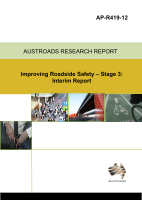Road Safety

Improving Roadside Safety - Stage 3: Interim Report
- Publication no: AP-R419-12
- ISBN: 978-1-921991-55-4
- Published: 8 November 2012
- PDF (free) Download
The objective of this project is to improve the safety performance of roadsides. The Stage 3 interim report of this project presents the project findings achieved during the 2010-11 financial year. Stage 3 builds on findings and recommendations of the previous two stages by undertaking more detailed investigations of the three areas. In addition, Stage 3 sought to review road agency practices/processes for balancing environmental impacts of roadside safety management.
- 1. INTRODUCTION
- 2. PART 1: ROADSIDE HAZARD MANAGEMENT
- 2.2.1. Project Stakeholder Consultation
- 2.2.2. Literature Review
- 2.2.3. Investigation of Severity Indices
- 2.2.4. Analysis of Crashes into Poles (Site Visits)
- 2.2.5. Practices for Balancing Environmental Impacts of Roadside Safety Management
- 3. PART 2: SELECTION AND PLACEMENT OF SAFETY BARRIERS
- 3.2.1. Project Stakeholder Consultation
- 3.2.2. Literature Review
- 3.2.3. Development of a Project Database
- 3.2.4. Data Analysis
- 3.3.1. Background
- 3.3.2. Project Stakeholder Consultation
- 3.3.3. Review of Literature on Barrier Performance
- 3.3.4. Review of Safety Barrier Test Performance Standards
- 3.3.5. Selection of Different Barrier Types – Data Analysis
- 3.3.6. Placement of Barriers – Data Analysis
- 3.3.7. Summary
- 3.4.1. Background
- 3.4.2. Barriers in Wide Medians
- 3.4.3. Barriers in Narrow Medians
- 3.4.4. Issues with Flexible Median Barriers
- 3.4.5. Summary
- 3.5.1. End Treatments
- 3.5.2. Transitions
- 3.6.1. Energy Absorbing Pole/Tree Buffer (EAPTB)
- 3.6.2. Raptor
- 3.6.3. Summary
- 3.7.1. Background
- 3.7.2. Motorcyclist Fatalities Due to Safety Barriers
- 3.7.3. Conventional Barrier Systems
- 3.7.4. Types of Solutions
- 3.7.5. Examples of Solutions
- 3.7.6. Relevant Testing Standards for Motorcyclist Barrier Solutions
- 3.7.7. Summary
- 3.8.1. Background
- 3.8.2. Overview of Current Australasian Guidelines
- 3.8.3. Heavy Vehicle Barriers Used in Australia and New Zealand
- 3.8.4. Performance of Barriers in Heavy Vehicle Crashes – Crash Tests
- 3.8.5. In-service Performance of Barriers in Heavy Vehicle Crashes
- 3.8.6. In-service Performance of Barriers in Heavy Vehicle Crashes – Data Analysis
- 3.8.7. Summary
- 4. PART 3: CLEAR ZONES
- 4.2.1. Project Stakeholder Consultation
- 4.2.2. Literature Review
- 4.2.3. Modelling of Clear Zone Widths and Crash Outcomes
- 4.2.4. Clear Zone Selection Guidance
- 4.3.1. Background
- 4.3.2. The Clear Zone Concept
- 4.3.3. Roadside Hazard Offsets and Crash Outcomes
- 4.3.4. Run-off-road Crash Impact Conditions
- 4.3.5. Roadside Safety Performance in Different Clear Zones
- 4.3.6. Crash Reduction Factors for Clear Zones
- 4.3.7. Summary
- 4.4.1. Project Stakeholder Consultation
- 4.4.2. Road Feature Data
- 4.4.3. Crash Data
- 4.4.4. Traffic Volume Data
- 4.4.5. Building the Project Database
- 4.4.6. Proposed Analytical Methods for Stage 4
Related publications
WEB-ZRT-24
Latest Road Safety News
